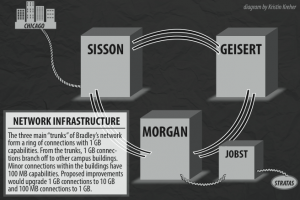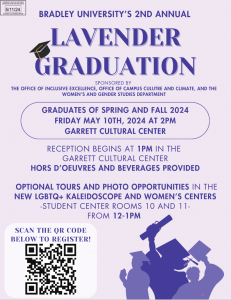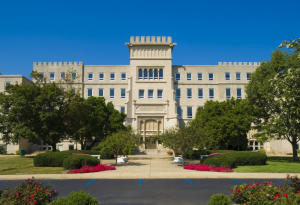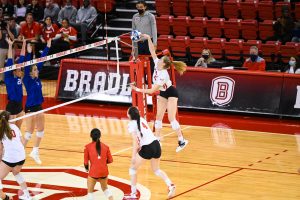A casual scroll through Yik Yak quickly reveals student frustrations with Internet on campus, but the real issues go beyond what is seen on social media sites. Although students may be sharing concerns with their peers, the problems are going largely unreported to official university departments.
According to Chuck Ruch, associate provost for Information Resources and Technology (IRT), only three tickets for network connectivity issues have been opened at the Technology HelpDesk since the beginning of the year.
Student Senate’s Vice President of Technology Services Mitch Pericak said students might be hesitating to file reports because they have little hope of the issue getting solved.
“The reason I feel kids aren’t reporting it is because of the fact there were so many problems last year,” the sophomore electrical engineering major said. “It’s the norm this year. Kids are learning this year to just deal with it.”
Ruch, however, said this is not the approach he wants students to take.
“That is not our philosophy, and it is not what we’re aiming for,” Ruch said.
University Provost and Vice President for Academic Affairs David Glassman said he believes fast, reliable Internet access is important to a student’s college experience.
“Technology has become essential to higher education and the university environment,” he said. “It is important that we provide robust, secure and reliable network services.”
Connectivity issues seen across campus
Difficulty connecting, slow speeds and getting kicked off the Internet are common wireless issues for students, but Pericak said the biggest concern he has seen is a decreased quality of Ethernet connections.
“When the Ethernet is starting to lag on students and they can’t watch a video for class, that’s when it’s becoming a big problem,” Pericak said. “Last year, Ethernet was a surefire way to connect; this year, even that is having a hard time.”
Pericak said he has seen Ethernet connections jump between no connection and a 90-megabytes-per-second connection, which causes problems for tasks such as buffering YouTube videos. With issues like these, being unable to connect to the Internet can have a significant impact when trying to use it for educational purposes.
“When the Internet is down and all of our homework assignments are online, that can really hurt students,” Pericak said. “It can severely impact a student academically.”
In addition to Ethernet issues, complications with wireless connections have caused frustrations for students across campus. HelpDesk Consultant Jason Blumenthal said he has seen problems with spotty connectivity in residence halls and St. James apartments.
“With the residence halls, you see issues because there is so much saturation in them from all of the wireless signals,” Blumenthal, who also serves as Student Body President, said. “In St. James, connecting from the back bedrooms may give students problems.”
Pericak said he has specifically received complaints about poor wireless connection in the upper floors of Williams, Harper and Geisert, which are areas with recurring problems rather than isolated events.
From an administration standpoint, part of the problem is lack of awareness. Without students making official reports or opening tickets at the HelpDesk, specific issues are unlikely to be resolved.
“If there are problems, there is definitely a disconnect because we are not getting complaints about it,” Ruch said.
Usage habits, infrastructure pose problems
The causes behind these problems stem mainly from changes in media habits, the structural design of buildings and an overall outdated infrastructure.
“When the network was originally set up, the thought process was that each student would have two devices per [residence hall] room connecting to the network,” Blumenthal said. “Now, you may see seven different devices per person with 14 devices per room.”
Ruch said not only has the number of devices connected to the network increased, but the uses of those devices have changed as well.
“There have been tremendous changes in the amount of video that is being viewed,” Ruch said. “[This] has a big impact on capacity in terms of immediacy because it relies on continuous flows of data rather than bursts.”
According to Ruch, video streaming, video games and campus security cameras all use continuous flows of data like this, which requires large amounts of network capacity.
As far as wireless issues in residence halls, Pericak, Blumenthal and Ruch each stressed that the buildings are not designed in ways that are conducive to wireless transmissions.
“These buildings are made from cinderblock,” Blumenthal said. “They’re not good for wireless signals. They were made for safety, not for Wi-Fi .”
In contrast, academic buildings are better designed for these wireless connections according to Ruch and Pericak. However, issues still occur in some of these buildings, specifically Baker and Jobst.
“We’ve fought the battle with these buildings for a number of years,” Ruch said. “We know there are problems. Our issue is that there is a belief that the days are numbered for that building.”
Although user habits and building designs contribute to issues, the real root of the problem lies in the infrastructure of the Internet on campus. Because of outdated equipment and connections, the total capacity of the network is limited, according to Ruch.
As seen in the accompanying diagram, the mainframe of Bradley’s Internet consists of three trunks in Sisson, Morgan and Geisert. These three locations form a ring with one-gigabyte connections. All ports across campus branch off from this mainframe at some degree, with major connections of one-gigabyte and minor connections of 100-megabytes.
Bradley’s network accesses the Internet through a major connection running from Sisson to Chicago. This serves as the main connection to the Internet, while a smaller back-up connection runs from Morgan to Jobst to a local company called Stratas.
When issues with the Chicago connection occur, the network is able to operate at limited capacity through the local connection.
Because the network can only accommodate so many connections, users see their Internet slow down as the total network usage approaches maximum capacity.
IRT makes strides with improvements
According to Ruch, IRT has begun making improvements by adding access points, changing how bandwidth misuse is controlled and installing new firewalls.
This fall, access points have been added to enhance connectivity in residence halls, specifically Williams.
As for regulating bandwidth usage, a new device called a “NetEqualizer” monitors browsing sessions.
Instead of allotting each user a certain amount of bandwidth like the old system did, the NetEqualizer looks at the total network traffic and compares it to the external connectivity speeds.
“With the NetEqualizer, you set a percentage of overall bandwidth,” Ruch said. “Until you get to that percentage, it doesn’t restrict anything. Then when you go over that, it starts looking for what I refer to as ‘bandwidth hogs’ and puts them into a penalty box. It identifies those people using the most traffic, the most resources, and it restricts them.”
The NetEqualizer may limit students for reasons such as acting as peer-to-peer servers or operating through personal routers.
“The issue with routers is they are recognized [by the NetEqualizer] as single devices,” Ruch said. “When a router has multiple devices connected to it, they are likely to be restricted because they are using significant amounts of bandwidth.”
In addition to the NetEqualizer, two new Palo Alto firewalls with 10-gigabyte capabilities have been installed, but they currently operate at one-gigabyte because of the limited capabilities of the Internet mainframe.
Infrastructure updates still to come
Despite these improvements, there are still noticeable issues with Internet on campus. Ruch, however, said IRT has plans to improve the infrastructure.
“The first step is to change the support mechanisms of the network to increase overall capacity,” Ruch said.
This would involve changing all of the aforementioned one-gigabyte connections to 10-gigabytes and changing the 100-megabyte connections to one-gigabyte.
According to Ruch, the next step would be to create a second connection to Chicago. This would involve making another connection like the one leaving Sisson, which would provide a higher quality backup system if the main connection has issues.
These improvements, which Ruch said he hopes to make in phases over time, would involve a multi-million dollar project that would require an additional allocation of funds.
“IRT has spent a significant amount of funds preparing for the next major upgrade to the network,” Glassman said. “As of today, no request has been received for additional funding, although I do expect a request this calendar year.”
Prioritization of the infrastructure improvement project will be determined in relation to other needs of the university.
“As with all needs for the university, once a request has been received, it is evaluated against all competing requests and evaluated for prioritization,” Glassman said. “Implementation of university needs follow strategic planning in guiding the process.”
Ways to improve Internet now
Although a major overhaul will take time, simple measures may be taken now to experience better Internet connectivity.
According to Blumenthal, one quick fix is to use a hardwired connection to access the network through Ethernet, which offers more reliability than wireless.
“Ethernet is going to be ten times better,” Blumenthal said. “It’s a hardline; it’s not having all these issues with building designs.”
Students are also encouraged to eliminate personal routers and avoid peak times of Internet usage, which encompass typical business hours.
The most effective way to solving issues is to report them to the appropriate departments, according to Ruch.
“Whatever the problem is, I assure you we want it fixed,” Ruch said.
One way connectivity issues will be addressed is by adding access points to the problem areas. Beyond this, the HelpDesk and IRT will work with cases on an individual basis.
To report issues, students may visit the HelpDesk and make an official report, which is referred to as opening a ticket. They may also email their concerns directly to IRT at apirt@fsmail.bradley.eduM.
Students can file a constituency report with Student Senate via Pericak. Those interested in learning more may attend the Oct. 20 General Assembly meeting in the Garrett Multicultural Center, during which Ruch will discuss Bradley’s network.
Bradley’s wireless networks
Bradley provides four wireless networks across campus. Each network has its own purpose and should be used likewise.
• BUsecure: for students and faculty, requires users to identify themselves with a BUnet ID and password, encrypted
• BUguest: for a guest without a BUnet ID, limited capabilities, not encrypted
• BUsponsored: for guests coming to campus for major events or presentations, requires a person with a BUnet ID to sponsor the user and be held responsible for the user’s activities
• BUother: for miscellaneous connections such as game consoles, devices need to be registered with the HelpDesk









